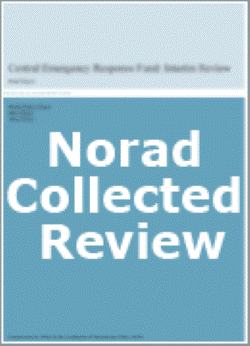Cooperation in education development the CED Programme PAL 0023
Om publikasjonen
- Utgitt: juli 2008
- Serie: Norad-innsamlede rapporter
- Type: Norad-rapport
- Utført av: Ma’an Consultant team: Randa Hilal, Khawla Shakhsheer & Habash Consulting Engineers
- Bestilt av: The representative office of Norway Jerusalem, The ministry of Education and higher education (MEHE)
- Land:
- Tema: Utdanning og forskning
- Antall sider: Report: 114, Annexes: 184
- Serienummer: 9/2008
- ISBN: 978- 82-7548-303-2
- ISSN: --
- Prosjektnummer: PAL-0023

The Project
The Co-operation in Education Development programme (CED) was agreed between the Kingdom of Norway and The Palestinian Authority. The goal of phase 1 (1998-2005) was to "ensure access to quality education for girls and boys in safe physical learning environment". In phase II (2003-07) the goals were: with emphasis on basic education, secondary education and school construction to contribute to 1) improving and raising the quality of education, ensuring equality in educational opportunities, 2) maintaining a safe, accessible and suitable educational environment, improving the capabilities of the educational administrators and enhancing their working environment. The main components were: 1) Construction & rehabilitation of schools and administrative buildings, 2) Teacher Training In-service Program (TTIP) 3) Technical & Vocational Education & Training (TVET).
Interesting Findings
• The component on Infrastructure. Findings showed that in its two stages (CED-I & CED-II), it has contributed to MEHE (Ministry of Education and Higher Education) frame work of General Education that requires applying the standards of Inclusive and Quality Education according to the Five Year Plan 1 (2000-05). This resulted in increasing the capacity of the education system which helped absorb part of the annual increase in school population through the construction and furnishing of new schools and the extension and rehabilitation of existing ones in Gaza and West Bank. However; providing opportunity for gender equality by the CED through providing access to school girls was jeopardized by the school gender changes that took part in CEDII, by changing gender of the two schools in Gaza from Girls to Boys, reducing the percentage of girls benefiting from the CED infrastructure component of both phases from over 60% planned to 45% actual.
Findings revealed that there are no systemized gender mainstreaming at the ministry, no gender related policies, no mechanisms or monitoring system in place. This could jeopardize any gender supported activities and related results, such as changing school gender of supported projects.
• The component on Teacher Training In-Service (TTIP ). Findings indicate that CED phases I & II successfully achieved the objectives as planned, clearly contributed to enhancing quality of education and to the achievement of the MEHE Five Year Plan (2000-05). MEHE staff insistence, enthusiasm and the continuous support from Norway helped to carrying out the project activities in spite of all the obstacles encountered.
• The component on Technical, Vocational Education & Training (TVET) contributed to the gender equality in education by providing access of women to quality education in a male dominated field in Vocational Education. It provided a model that spread over various other areas. It contributed to a changing perception of society towards female participation in industrial vocational education.
• Findings of gender and inclusive education. In summary; the CED programme of both phases (CED-I & CED-II) had a clear impact on the ground and has contributed to gender equality, universal education and quality education. Yet contributing to gender equality in education was not accompanied by measures for gender equity, leading to isolation and disparity, contributing to gender exclusion of the socio-economic structures and negatively affecting women equality and empowerment in the long run.
• One value added by the CED-II was its ability to continue providing educational services during years of high tension and increased occupational measures against the Palestinian people. As mobility restrictions became an issue, many donors moved from development funding to emergency funding. CED-II, however, continued in the year of 2006 when many other projects were halted or delayed due to the imposed embargo on the PA. As a result CED gained respect by the PA and the Palestinian communities.
